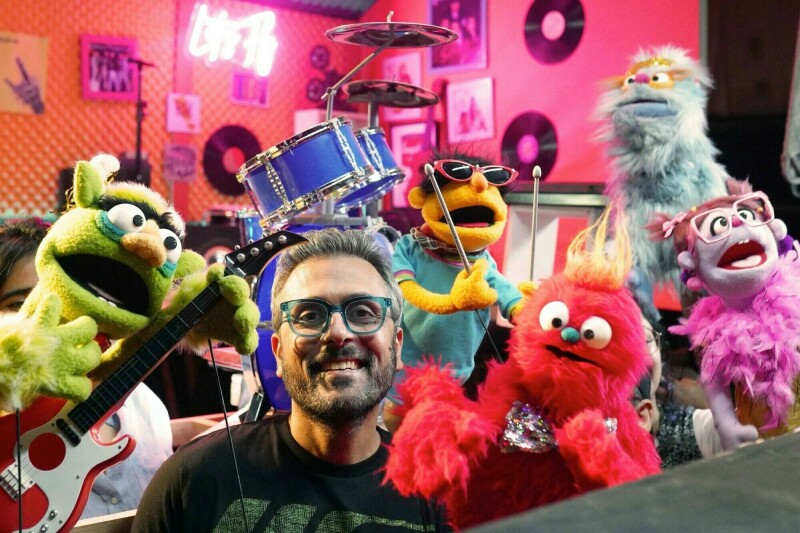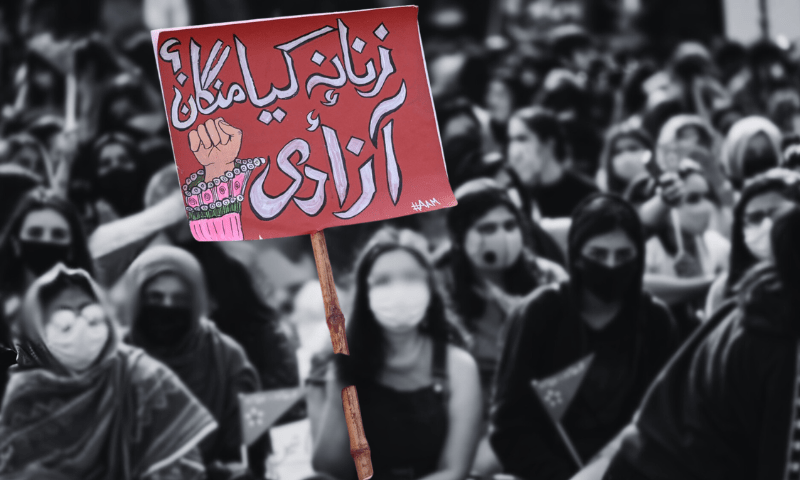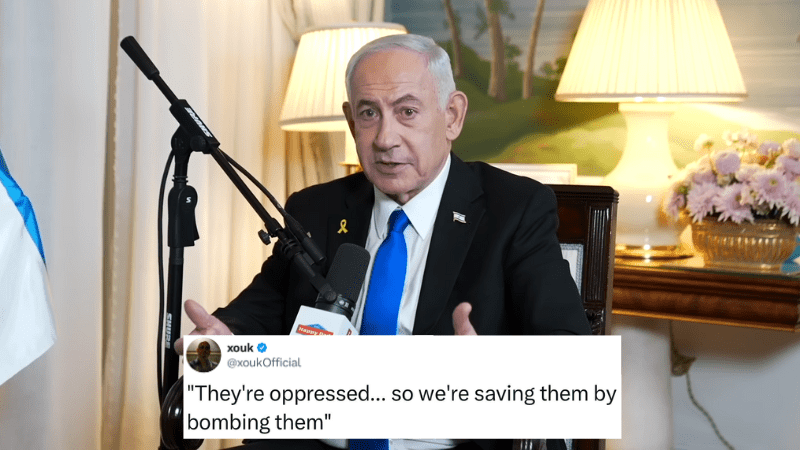It was suggested we dedicate the [fourth] Lahooti Melo to the #MeToo movement: Saif Samejo
It looks like we’re in the middle of nowhere. You’d miss the house if it weren’t for the colourful lights that guide you to it — on the outskirts of Jamshoro. Saif Samejo likes his space.
Far from the maddening crowd of the cities, is his home, work and creative space, a part of which forms the Lahooti Music Ashram, complete with a performance area equipped to seat audiences and fortified by glass for better sound.
Next to it, inside, is a common area with rooms for visiting artists to stay while they’re recording with Saif Samejo and Nomi Ali, the duo who form band The Sketches. The family lives in another part of the house.
It’s been a busy year for the duo and Saif Samejo in particular. The third instalment of the two-day music festival, the Lahooti Melo, took place earlier this year. They did the soundtrack and score for Cake (2018) directed by Asim Abbasi, the film later nominated as Pakistan’s entrant for Oscar consideration in the Best Foreign Language Film category.
The Sketches released a 10-minute epic song on Coke Studio called Dastaan-e-Moomal Rano, based on the poetry of Shah Abdul Latif Bhittai. And if that weren’t enough, they just released a new music video titled Meri Dunya, with plans to release a couple more before the year ends.
It’s in the performance area, surrounded by plants and little trees, that musician, producer, festival director Saif Samejo and I have our conversation about his upcoming plans and the events that led him to reconsider holding the next Lahooti Melo.

A couple of months ago, the teaser for the film Jugnu, directed by Ali Abbas Naqvi and produced by Jami, was released online. The story follows a boy, Buhra and his pet goat, and it’s set in a village in Sindh. It’s visually beautiful but what complements the stunning scenery is the earthy music that plays along with it. Jugnu will be the second film Saif Samejo and Nomi Ali will do the soundtrack and score for. What do they have planned for this one?
“It is indigenous, it has that folk feel and, at the same time, it’s very modern,” he says. “There’s the flute, matka, surundo and khartaal which are two wood pieces you clap together. Sindhi Sufi fankaar [artists] usually have an ektara in one hand and khartaal in the other. They create the beat and tempo with that. It makes you move, dance. There’s also pain in it.
“We’ve featured the faqirs of Bhit Shah as well. They’re not really open to experimentation. They are committed to their tradition. We let them sing what they always have, but we try to change it slightly so it sounds new to our ears.”
He also travelled to Nepal to record some of the material used in the soundtrack. “I always go to musicians who sound a little raw and haven’t been cornered by more commercial elements,” he relates. “Their sound is still… exclusive. They play from the heart. There is Omaish who plays the flute. He played [the raag] Kalyaan which we used in a song called Ishq laga mann jaga.”
But one instrument that really stands out is the shankha — the shell of a large predatory sea snail. It’s used as a trumpet in Hindu rituals and, back in the day in South Asia, was used as a war trumpet. The sound it creates, when a musician blows through it, comes across as both beautiful and mournful at the same time.
Saif met a wandering ascetic, a sadhu, living in a commune in Nepal. “He used to scream all night, like a wolf howling at the moon. We didn’t know why he did it because, in the daytime, he was quite peaceful. He plays the shankha that we’ve recorded — the different moods of it.”

“We’ve used the shankha at the end of one of Jugnu’s songs,” relates Saif. “Right now, we’re thinking perhaps it goes well with the closing credits. The song goes like this: Ishq laga, mann jaga. Mein soya, mann jaga.”
The shankha solo recorded for the soundtrack for Jugnu is so hauntingly beautiful it gives me goosebumps every time I listen to it.
Introducing: Ustad Murphy
Anyone who’s been to the Lahooti Music Ashram has met Saif’s furry little black-and-white dog and constant companion Murphy. He’s a Shih Tzu and poodle mix or a ‘Shih Poo’. Not surprisingly, Murphy has a flair for music.
One noticed that every time the flute solo in Dastaan-e-Moomal Rano, the song The Sketches did for Coke Studio played, Murphy would get up (even if he was asleep) and scurry to a speaker or Saif and begin howling perfectly in tune with the flute. And he kept up with the flute playing with a little performance of his own.
“He’s been interacting with artists that have been coming to the studio since he was a puppy,” laughs Saif. “Murphy likes wind instruments. He’s not trained, but he always howls perfectly in key.”

Murphy first started showing off his ‘talent’ roughly around four years ago. “We were recording an alghoza (two-flute instrument) player in the studio. Murphy was getting very uncomfortable and started howling. It was impossible to record because you could hear him every time we recorded the flutes.”
They decided to stop everything. “I asked the alghoza player to play each flute one by one. It turns out one of the flutes was a little out of key with the other. And Murphy was howling in the right key the entire time!
That’s when Murphy became Ustad Murphy. “Murphy has a huge fan club in the artist community,” says Saif. “He’s does duets with some of them too.”
Lahooti Melo:
Earlier, Saif had mentioned to me that he and his team had decided that they would not be doing another Lahooti Melo. This was shocking, considering that the Melo has now become one of the biggest music festivals held in this part of the country. I asked him why.
“We like to engage young people when we’re working at the festival,” he began. A lot of those that volunteer and attend the festival as audience members are students between 16-19-years-old who get an opportunity to interact with professionals up close in the media and music industry. This provides them with access to opportunities in the future for career guidance or work etc.
“I saw women with the courage to share their stories, who were being very brave, and the backlash [they would get]. Their stories are haunting me,” says Saif.
It was shortly after the third Lahooti Melo earlier this year, when a group of young people were gathered at the Lahooti ashram, that a young girl found the courage to open up to Saif about a harrowing ordeal she had suffered at the hands of one of the guests from the first festival in 2016.
It was difficult for Saif to recount what had happened. He would often choke up in between. “He tracked her down on social media [after the festival concluded],” relates Saif. “He knew she was an artist and began complimenting her on her work. For someone who is very young and new, to have a known person show this much attention is a big deal,” adds Saif.
To cut a long and painful story short, the media person, in classic predator fashion, stalked his victim and got to know everything about her. He took his time to foster trust and a sense of closeness and eventually suggested they meet at the studio at his house.
Once there, he introduced her to his family, shared his own personal struggles, how he thought of her as his own child etc in an effort to make her feel comfortable. And just as she started to feel safe, he took advantage of her and forced himself on her.
“She felt lost afterwards,” adds Saif. “She felt like he had killed her soul and that she was completely helpless in front of such a well-known person.” Most victims, when undergoing trauma experience three kinds of reactions: fight, flight or freeze. The latter is quite common in which a victim is in such a state of shock he/she is unable to respond, react and they feel physically powerless.
It took her a few months to come to terms with what had happened. A short trip abroad didn’t help either. “The trauma was still fresh,” he relates. “She tried to commit suicide, twice. [Each time] she got some sleeping pills and took all of them. And then disconnected herself from everything.”
“I know several people who were named as predators. They are from this industry. They come to our events. These are the people we’re supposed to introduce to the younger generation as role models?” he asks.
Then the #MeToo movement happened. “I saw women with the courage to share their stories, who were being very brave, and the backlash [they would get]. Also, men like this media person who [sensing that their time might be up] would preemptively generate a narrative [around themselves], so that if they are accused, they can get away with it.”
But this issue isn’t restricted to the media industry alone. “These people exist in our cities and villages,” he adds. Eventually Saif turned to the online space and started speaking out against harassment and this culture which makes it easy for predators to take advantage of young people. His inbox was immediately flooded with responses from people, most of whom he knew personally, detailing their ordeals.
“Their stories are haunting me,” says Saif. “I know several people who were named as predators. They are from this industry. They come to our events. These are the people we’re supposed to introduce to the younger generation as role models?”
Feeling an immense sense of responsibility towards the individuals that attend the Melo, Saif and his team decided that they weren’t going to hold the festival anymore. “Because we don’t know who we’re calling and exposing to these young people,” he explains. “But it was [recently] suggested that we should do the [fourth] Melo and dedicate it to the #MeToo movement. To use our setback, turn it into our power and make people aware. I felt a little more hopeful then.”
However, he’s been very shocked, disappointed and disillusioned by the reaction he’s gotten from some of the people in the industry that he’s spoken to. “They said ‘Woh to hai hi aisa’ [Oh, he’s always been like this],” he says amazed. “My question to them is: then why are you still working with him? Stop working with this person. That’s the least they can do. Iss society ki zimmedari kidhar hai? [Where is this society’s responsibility?]”
“If they can’t break off with people like him, then they are a part of the problem. We grew up being told that artists feel the pain of society. Yeh kaun se artists hain jinn ko samaaj ke dard se koi leyna deyna nahin hai?” [What kind of artists are these that have no truck with society’s pain?]
Originally published in Dawn, ICON, November 11th, 2018

![It was suggested we dedicate the [fourth] Lahooti Melo to the #MeToo movement: Saif Samejo It was suggested we dedicate the [fourth] Lahooti Melo to the #MeToo movement: Saif Samejo](https://i.dawn.com/primary/2018/11/5be7c927c07ea.png)











Comments